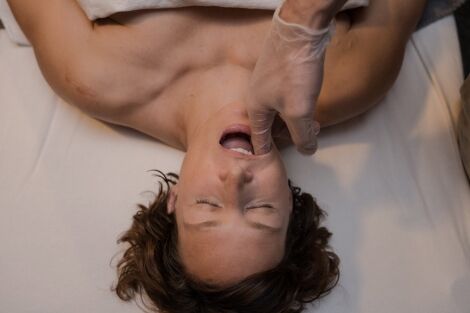Around 12% of individuals suffer from TMJ disorders. The TMJ is a hinge joint connecting the lower jaw and the temporal bones located on each side of your head, directly in front of the ears. When healthy, the TMJ is flexible, allowing the jaw to move freely up and down, and side to side. In turn, this allows for easy chewing, speaking, and yawning. When a person has TMJ disorder, the joint is stiff and any movement can be extremely painful. The disorder can also cause pain in the neck and shoulders. A TMJ Massage will help to relieve the painful symptoms of TMJ disorders and get your jaw back to functioning as normal, eliminating pain, restoring jaw motion, and decreasing stress and tension.
45 min | 60 min | 90 min | 120 min

your first your first massage!
45 min | 60 min
If you are experiencing irritation, pain, stiffness or tenderness in your jaw area, difficulty eating or talking, earaches, hearing problems or dizziness, or have been diagnosed with a TMJ disorder, a TMJ Massage is the right service for you.
Your treatment will begin with a short assessment which will include ROM and strength testing. Your massage therapist will go over your condition, health history, pain levels, and lifestyle. and any issues you want to address. You may or may not be asked to partially undress and lie under the linens on the table.
During the treatment, your massage therapist will work on the muscles that surround the temporomandibular joint. This may include the muscles in your neck, shoulders, and face. The therapist will also work with gloved hands on the inside and the outside of your mouth to access your TMJ and release the inner workings of the jaw. In TMJ Massage, your therapist will use a technique called myofascial release (MFR). MFR is a form of massage that involves the application of sustained compression over trigger points in your face. Your individual treatment plan will be determined by what you present both verbally and what is ascertained from palpating your soft tissues.
You may feel some discomfort or tenderness during a TMJ massage. It is important to maintain a dialogue on your comfort levels so your therapist can make adjustments with the pressure and techniques being utilized.
After the massage, it is important to take care of your jaw and avoid activities that may exacerbate your symptoms. This may include avoiding hard or chewy foods, practicing good posture, and avoiding excessive jaw movements (such as chewing gum or clenching your teeth). Your massage therapist may be able to provide additional tips for managing your symptoms and preventing further damage to your jaw. A return date for your treatment plan will also be suggested to keep you on track.
TMJ massage therapy is designed to help alleviate pain and discomfort that may be associated with conditions such as TMJ disorder or bruxism (teeth grinding). TMJ massage can be a highly effective treatment option for many people, but it is not suitable for everyone. It is important to note that TMJ massage therapy is not a cure for TMJ disorder or other jaw-related conditions. While it can provide relief from pain and discomfort, it may not address the underlying cause of the problem. If you are experiencing persistent pain or discomfort in your jaw, it is important to talk to your doctor to determine the best course of treatment.
If you’re planning on getting a TMJ Massage, here are some important things to keep in mind:
Click the BOOK NOW button to schedule your TMJ Massage appointment today. Our registered massage therapists are ready to assist you in living a pain free life.
TMJ, temporomandibular joint, disorders were described as early as the Ancient Egyptians. However, medicine and treatment have come a long way. In the past, procedures were much more invasive and focused on dental issues and function.
Today, the focus is on chronic pain management – where the treatment, such as TMJ Massage, is non-invasive and involves a multidisciplinary approach.
TMJ massage is a type of massage that targets the temporomandibular joint, which is the joint that connects your jawbone to your skull. This type of massage can help relieve tension and pain in the jaw, neck, and head caused by conditions such as temporomandibular joint disorder (TMJ).
During a TMJ massage session, the massage therapist will use a combination of techniques to help release tension in the jaw, neck, and head muscles. This may include gentle pressure on the jaw, temples, and neck, as well as stretches and range-of-motion exercises.
Anyone who experiences pain, discomfort, or tension in their jaw, neck, or head may benefit from TMJ massage. This includes people with TMJ disorder, teeth grinding, stress-related jaw tension, and other related conditions.
TMJ massage should not be painful, but it may cause some discomfort if the muscles are particularly tense or if there is an underlying condition causing the pain. It is important to communicate with your massage therapist throughout the session and let them know if you are experiencing any discomfort or pain. They can adjust the pressure and technique accordingly.